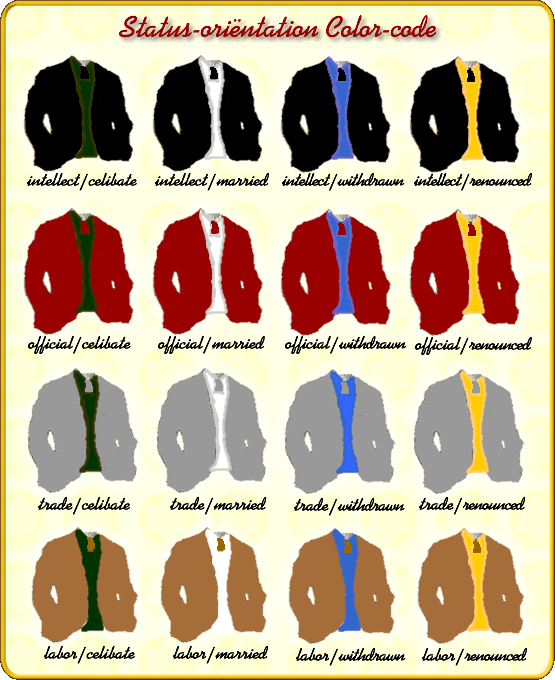
DESIGNS
Design
2 Status-orientation
Color-code
There is a general
dislike for uniforms and formality because we have
experienced a lot of estrangement and warfare of
individuals and groups with it. After the worldwars thus
a pacifistic movement found its way into existence, a
general abhorrence against general drafting and such. The
uniformed was vehemently fought in demonstrations and
illegal occupations. The question though is what, if we
want to abolish the uniformed, then would be the
alternative for the impersonal gray, green and blue
outfits. One could also say:
"...a society
without a clear concept of formal (liberating)
order is on the way of selfdestruction."
(T.O.R.
2 m).
Thus seen is anarchy
not directly an attractive alternative. Therefore the
thoughts went out to an intermediate form between the
impersonal uniformed and the personal taste-dependent
fashionable clothing in the informal casual sphere.
Problem of the general uniform is that it does not
discriminate between the kind of person that is in it.
And that contributes to and is a symptom of the
destructive estrangement and extremities of right-wing
fanaticism e.g.. Thus one could express e.g.
the
identity of age and
vocation
(social background) and that way (partly) ban the
depersonalization and estrangement of formal
groupclothing. That way one can have representation and
still an identifiable persona that can be recognized qua
age , social background or vocation and a
certain degree of commitment
or
development
(wisdom,
experience). By being able to identify as such one will
then be freed from the pretense of power or the monopoly
of a uniformed organization. One will then have a greater
feel for the relative in performing ones duties and more
clarity to civilians the way they also would like to
belong to nothing at all. The danger of a purely material
class-division, the way one sees it e.g. in the indian
cast-system, can be precluded by distinguishing to the
last mentioned experience. The degree in which someone
does or does not live materially motivated, the
transcendence
or rising above,that
ultimately determines the anxiety one feels for and with
such a thing, escapes though (by and by) material
standards and is thus difficult to express in formal
characteristics. The underlying designs is therefore best
seen as a kind of professional clothing for formal
functions as known of governmental institutions as the
police, the army, the fire brigade and other forms of
control and management-service, in the sphere of being
l;iberated from material duties. Obedience of such a form
of representation to decisions made by a democratic
government stays of course a preliminary condition as
assuredly the government has in part been derived from
that order of liberation.
People though with a
warm heart for identifying themselves with the Order of
Time or with a practical need for a formal form of
representation of the interests of The Order of Time are
free to express themselves to their professional
orientation and
civil
status in the
form of the below indicated colorcode for e.g. their
clothing. The characteristic of authority is in this not
anymore an exclusive right of the government. A company,
or a religion or a conviction the way it is defended
here, is also in need of its company- or formal outfit so
that an individual or a free organization may also give
the right example, that with things like this a different
course can be followed. All organization at this point is
ultimately bound to the local rule of the police and
other official measures as long as politics didn't join
in themselves. The idea is that from the right set of
human values never serious offenses can come about, not
even a dictature of christian fundamentalism of social
imposition and fear, that is not founded on a form of
selfrealization as it is meant in the filognosy
right here.
The proposition is to
have the color black as the formal identification for the
dress of the intellect (including the priests). The color
dark-red is recognized as the color of the official
professions (government /military). Gray is the color for
the people in trade, while laborers have the color beige
as their identity of clothing. Personal status,
independent of the professional orientation, can be
expressed by means of the color of the shirt: green for
the celibate available for marriage (celibate/student),
white for the people married, blue for the people
withdrawing from marital commitment and orange for the
status of detachment. Neckties have been replaced by a
small band (or collar) in the color of the professional
orientation to give expression to the identification with
The Order of Time. From this band also decorations can be
hung showing the degree of commitment: aspirant,
recognized and prolonged service resp. wearing no star, a
silver star and a gold star in accord
with
the logo of The Order of
Time. Thus 48
possible representations are conceived.
This concept is thus,
again, not directly meant as a replacement of uniform
clothing, but as a intermediate that eventually makes the
uniformed function better and even is able to push it
back partly. After all it is not possible to have more
and more police in the streets and less and less people
who still dare to do 'it'. Factually it is only a
colorcode and not so much a uniform design of clothing,
with which each fashiondesigner may improvise (no claims
of patent here), to answer to the need of people to
belong to something and identify themselves. Compare also
the picture below with the picture of
the filognostic guide of
general
human appearances
as divided in formal/informal and liberated/non-liberated
appearance. Thus the schedule below refers to the formal
appearance of the libertated person.
(see
further: The
Game of Order)







